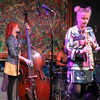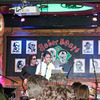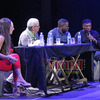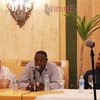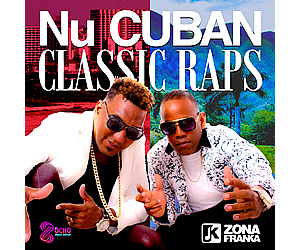Indice - Table of contents
New Stuff[hide]
Reportes: From The St... : Jazz Plaza ...
Fotos: Tom Ehrlich : Irakere 50th Annivers...
Fotos: Tom Ehrlich : Irakere
Resenas: Joey Altruda Presents: El Gran ...
Reportes: From The St... : Cubadisco 2...
Timbapedia: 09. Interviews -... : Carlos del Pino ...
Fotos: Tom Ehrlich : 2023 Monterey Jazz Fe...
Fotos: Tom Ehrlich : 2023 Monterey Jazz Fe...
Fotos: Tom Ehrlich : 2023 Monterey Jazz Fe...
Fotos: Tom Ehrlich : 2023 Monterey Jazz Fe...
Grupos: Tirso Duarte
Grupos: Tirso Duarte : Discography
Grupos: Charanga Habaner... : 8. El bla bla bla
Grupos: Pupy y los que S... : Tirso Duarte
Photos of the Day [hide]
SpanishEnglishEntrevista con Enrique Lazaga - Page 10
-- We’re interested in the idea that the amazing bloques of la Ritmo came from a charanga aesthetic. Can you elaborate on that?
The answer to that is nothing more than the search for new things. In the past, orchestras, charangas, conjuntos, Cuban music groups in general made a bloque or an effect and let’s say they repeated the same effect three times, something that the rhythm did by itself. Then, we started to look closely at it and started thinking, hey! Why does the rhythm have to do this? Let’s see if everybody can do it and we started to do it, all those kinds of things and new things emerged. Remember that inventions come from other inventions. You go looking for one thing, and another one emerges. That’s the way it is.
--What charangas or songs inspired you guys in the beginning?
Well, look. We were a hybrid between the Aragon orchestra and Fajardo’s; the Aragon orchestra because they were the precursors of chachacha and the Fajardo orchestra because it was a bit more aggressive —don’t forget, Fajardo’s conga player was Tata Güines—, so we tried to unite those two styles and out of it our style emerged.
--Would you say that you, or others in Ritmo Oriental, were influenced by the early recordings of Arsenio Rodríguez or his musical concepts?
Also, also, yes of course, of his musical concepts. In the past, what differentiated one group from another, was nothing other than their format, because everybody would play a little son, danzon and guaracha. Of course, there were things that a conjunto could play, like a danzon, but they wouldn’t be able to play it the same way as a charanga could play a danzon. But, on the other hand, a charanga could play a son as well as a conjunto could. You know what I mean? And a bolero and that stuff. That’s why the charanga for me, and it’s not because I was or am a member of a charanga, is the most complete group, the most complete musical format that has ever existed. All musicians should play at least once in their life in a charanga, because it gives you a wider vision of what Cuban music is.
--Was there any particular Arsenio Rodriguez songs that influenced the band or yourself?
No, because our thing was to do things… Look, we listened to Chappottín a lot, Chappottín had some terrible sones, and we admired him. We were huge Chapotin fans; how the piano, bass, bongo and conga would do masterly things and come together to make a sound that was just terrible! And Arsenio Rodriguez was a great composer and a guy who was really… We were, are lovers of those musicians who, being empirical musicians, or musicians who came out of nowhere, made songs that you can put on and listen to today…like Sindo Garay’s music, you ask yourself how could this man do these things with the guitar without studying. You know what I mean? So, we really admired all those people.
And I mean, I play the guiro, and I do arrangements, and I studied music. I studied with Layan, with Nia and that, but I really admire a man called Gustavo Tamayo. That man didn’t study music, but he played his instrument [the guiro] masterly and nothing was difficult for him. I used to ask myself, how does he do that?! I learned a lot listening to him, watching him, not because he taught me; but I saw his personality and then I witnessed how he would impose that personality onto his instrument. Gustavo Tamayo was one of the musicians who began with Frank Emilio, I later replaced him. I called him ‘my dad’ because he was a great man. Gustavo Tamayo was a great musician, that’s for sure.
--And you had several teachers, can you tell us more about the music schools opened for musicians. You said that many of the members of the band went to these schools when they opened after the triumph of the revolution.
The escuelas de superación were created for professional musicians like us […], who did not have formal training, musicians who had studied with their parents, or in other places, with private teachers. Then, the schools were created. They were opened by the union [musician’s union that formed after the revolution]. Later on, I worked as a teacher at the school [the Almadeo Roldan], as a percussion teacher. Well, everybody studied there, all of us. Later, Rafael Lay was also a teacher there…
Ours was the most beautiful epoch of that school because musicians went there looking specifically for what they needed, and the teachers we had were very young teachers who had just graduated from the ENA and they treated us very well, they respected and loved us. They could see that we had talent, and I don’t like to say this, but we were skilled musicians who needed polishing. And they did their best to teach us, they did their best, sometimes they would say, ‘You’re stuck, come over to my house later.’ I had a couple of teachers, the Valdes-Arnabals, who were the sisters of an orchestra director, who were really good to me; and the Larin sisters; they taught me lots. I’m really grateful to all these people. I learned lots of music with those people, along with my father; with Rafael Lay, who was a great teacher for me; with master Diaz-Nieto who led the Popular Concert Orchestra where I played the timpan, despite not having gone to school.
That orchestra was created by the members of the charangas and septets here. Lay was its first violinist and there were musicians from the Ritmo Oriental, Aragon, Estrellas Cubanas, and so on. And we played Beethoven, Schakowsky, Mozart, Juan Sebastian Bach’s Concerto for Two Violins, Haydn’s Concerto for Piano, played by Frank Emilio. We played those pieces in the Amadeo Roldan Theatre and there, in that orchestra, we got better qualitatively. I’m very grateful and I hope those kind of experiences are repeated today, because the musicians coming out nowadays are very complete, very good, but those things are needed.
- Daniel Diaz was also a teacher at the Havana Music School, and a greatly admired percussionist, can you tell us about him and what he did on the timbales that no one else did?
Yes he was the Ritmo Oriental’s timbale player. That was a guy who… well, I was reading a magazine the other day that mentioned his name along with a bunch of other timbale players but there is still a lot more that needs to be written about this musician. Gonzalito Rubalcaba himself said, ‘In Cuba there is a timbale player who is not talked a lot about, one who should be talked about a whole lot, namely, Daniel Diaz.’
I was telling you earlier that he studied with the master Fausto Garcia Olivera, one of the best teachers of caja and the drum set here, and I would tell him, ‘No, don’t take up the drum kit. Take what you do, what you learned, and apply it to the timbale.’ And he created a whole series of things that made even people abroad start talking about him.
Yes, Daniel Diaz was a teacher here. He had lots of students. He and I were teachers of popular music at the escuela de superación. He was a brother to me. We worked together for forty years, he, Juan Claro and I…
Look, I’m going to tell you a story, a couple of Japanese people came here once and went to see us. There were Claro, Daniel and I, and they asked us, ‘How long have you been working together?’ and we told them, ‘We have been together thirty-five years.’ They were astonished because, let me tell you something sincerely, [in my lifetime] I have only worked with these two people. Well, with time, of course I had to work with other people because, well, you know, time… But we worked together for some forty years. You know what that is?! Just by looking at each other, we knew what we were going to do. We created things out of nothing, out of the air. No, no, no… the truth is that I… I don’t like to talk about this because I become really emotional because these are things that you say and people don’t believe you, but forty years is not a day. That was forty years working together Daniel, Claro and I, travelling, working throughout all of Cuba. And even once Daniel —he died from this [working]—, he had a heart attack and he recovered and came right back to the orchestra and we were back again, and we were always together, always thinking about la Ritmo…
Let me tell you a story that says everything. The stages here in Cuba, where the bands play, when you go to play they are always full of people, fans, women, whatever. When we played, our stage was always full of musicians, especially percussionists who would almost prevent me from working because they came to see what we were going to do; what we were going to improvise at that moment. But we didn’t actually improvise lots on the spot; we improvised during the rehearsals, so that things were done well. Sometimes we would come up with something during an activity, but everyone would come and check us out, and when we did some new thing they would say, ‘Man, the truth is these guys are salvages. And that’s how it was and we were just normal, modest people. We got along very well with everybody. We have helped all the people we could, and so on. Life has given us that gift at least.
-What do you know about flutist Polo ?
Polo is with me working in the Charanga de Oro and he is also working with the Buena Vista Social Club. He is doing fine; he’s still healthy.
-We were wondering about María Baila el Son.
That’s by Rolando Vergara.
--Did Polo play all the solos?
Yes.
-I wanted to ask you about Por Hacerme Caso it has a really incredible intro, did you guys write out the music for your songs?
That’s by Rodolfo Bayan, and that arrangement is by Juan Crespo Maza. Remember that Juan Crespo Maza first joined la Ritmo playing the violin. Yes we wrote out the music. There were a few of us who did all the arrangements for the orchestra: Ramiro Reyes, the orchestra’s first arranger and director; later Juan Crespo Maza started arranging because at first, Ramiro Reyes was the only one who knew music; Ramiro Reyes, Juan Crespo Maza and I. Later on, it was Humberto Perera, Ramiro, Juan Crespo and I. And so on, the four of us were always the precursors of the orchestra.
--And how did you write out the bloques, for example, of Por Hacerme Caso; that is, did you mark them down on paper?
No, no, no, look. An arrangement is done like this, the composer first brings the melody and then the arranger arranges the rest of the song according to the melody, and that’s it. And, since we worked together in a team, we would work out the number during the rehearsals. And then, let’s say… Claro said, ‘People, why don’t we do this here?’ and the other, and the other and the song came out right there, you know what I mean?
--And the bloque in the introduction to Por Hacerme Caso, do you remember if it is in 3/4 time or…?
I don’t remember. We could sit and listen to it sometime.
--Ok, let’s do that, thanks for everything.
To hire the band please contact:
Edificio Focsa, Calle 19 esquina N, El Vedado, Cuba
CP 10400 (Tel) 832 2680; 838 1393; 832 6611
Correo: dennym@cubarte.cult.cu
Contact info for Martin Karakas: mkarakas@alumni.sfu.ca










